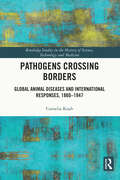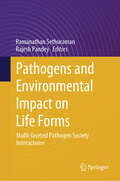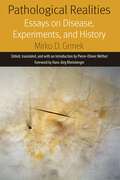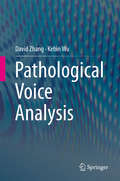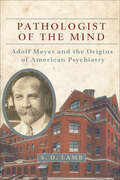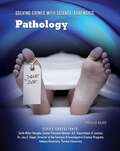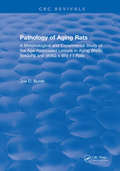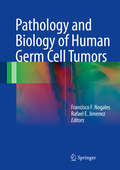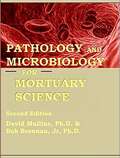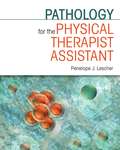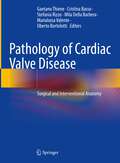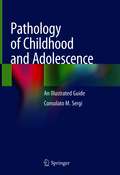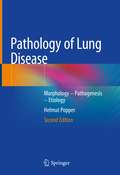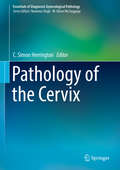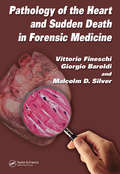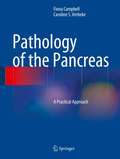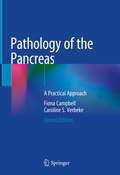- Table View
- List View
Pathogenicity and Drug Resistance of Human Pathogens: Mechanisms and Novel Approaches
by Saif Hameed Zeeshan FatimaThe book comprehensively discusses the mechanisms of pathogenesis and drug resistance; current diagnostics landscape of four key human pathogens; bacterial, fungal, protozoans and viral which are the causes of major infectious diseases. It also assesses the emerging technologies for the detection and quantification of these pathogens. Further, it discusses the novel opportunities to fight against these infectious diseases and to identify pertinent drug targets with novel methodologies. It also reviews the current and future insights into the control, elimination, and eradication of these infectious diseases. Importantly, the book discusses the epidemiological characteristics and various challenges in combating Ebola and Influenza diseases. Finally, the book highlights the growing role of nanotechnology and bioinformatics resources for combating the infectious diseases. In summary, the book provides the mechanistic insight of the pathogenicity, drug-resistance, therapeutic strategies and identification of the novel drug targets of Mycobacterium tuberculosis, Plasmodium, Candida, Hepatitis C and emerging viral infections.
Pathogens Associated with the Development of Cancer in Humans: OMICs, Immunological, and Pathophysiological Studies
by Noé Velázquez-Márquez Genaro Alberto Paredes-Juárez Verónica Vallejo-RuizThis book examines the relationship between the different infectious agents, such as viruses, bacteria, protozoa, and fungi, in the development of cancer. It is divided into six sections, spanning a range of topics, including infectious agents, main bacterial agents, and eukaryotic microorganisms, and how they contribute to cancer. Chapters also explore the anti-tumor effect of microorganisms, how pathogens induce epigenetic changes that are associated with cancer, and nutritional management for the prevention and treatment of pathogen-associated cancer, from a nutrigenomics perspective. The studies included cover epidemiological and immunological data, different OMICs data in general, and data of pathogens associated with cancer. The book is rounded out with an analysis of the role of glycans and molecular evolution in the progression of cancer.
Pathogens Crossing Borders: Global Animal Diseases and International Responses, 1860–1947 (Routledge Studies in the History of Science, Technology and Medicine #45)
by Cornelia KnabThe increasing globalization of trade, travel and transport since the mid-19th century had unwelcome consequences – one of them was the spread of contagious animal diseases over greater distances in a shorter time than ever before. Borders and national control strategies proved to be insufficient to stop the pathogens. Not surprisingly, the issue of epizootics (epidemics of animals) was among the first topics to be addressed by international meetings from the 1860s onwards. Pathogens Crossing Borders explores the history of international efforts to contain and prevent the spread of animal diseases from the early 1860s to the years after the Second World War. As an innovative contribution to global history and the history of internationalism, the book investigates how disease experts, politicians and state authorities developed concepts, practices and institutional structures at the international level to tackle the spread of animal diseases across borders. By following their activities in dealing with a problem area which was – and is today – of enormous political, social, public health and economic relevance, the book reveals the historical challenges of finding common international responses to complex and pressing global issues for which there are no easy solutions.
Pathogens and Environmental Impact on Life Forms: Multi-faceted Pathogen Society Interactome
by Rajesh Pandey Ramanathan SethuramanThis book underscores the effects of anthropogenic changes on microbes external to us and the consequences of the resultant environmental dysbiosis for our continued health and well-being. Since before the time of our last common ancestor, microbes have been shaping our evolution and our environment, just as we have shaped theirs. This fact has recently gained renewed prominence with wider acknowledgement of the microbiome (part of One Health) and its role in maintenance of human homeostasis. This two-part book titled “Pathogens and Environmental Impact on Life Forms” highlights the fluid dynamics we share with the microbes within us, including both, arguably ‘helpful’ species, and undoubtedly pathogenic ones (pathogen containment, clearance, and optimisation are dwelt on). Prominent examples include indiscriminate industrialisation and urbanisation. Both of these forces, empowered by a culture of consumerism, have led to excessive pollution and several detrimental lifestyle changes, which have culminated in our present obesity crisis and diabetes ‘pandemic’. Finally, this book concludes by emphasising that the way forward for healthcare is not only to be cognizant of the eubiotic microbiome in its diagnoses and treatments, but also to use this tremendous resource to contend with the quickly transforming landscape of infectious diseases.
Pathogens and Environmental Impact on Life Forms: Understanding Pathogens and Host Defence Mechanisms
by Rajesh Pandey Ramanathan SethuramanSince before the time of our last common ancestor, microbes have been shaping our evolution and our environment, just as we have shaped theirs. This fact has recently gained renewed prominence with wider acknowledgement of the microbiome (part of One Health) and its role in maintenance of human homeostasis. This two-part book titled “Pathogens and Environmental Impact on Life Forms”, highlights the fluid dynamics we share with the microbes within us, including both, arguably ‘helpful’ species, and undoubtedly pathogenic ones (pathogen containment, clearance, and optimisation are dwelt on).It also underscores the effects of anthropogenic changes on microbes external to us, and the consequences of the resultant environmental dysbiosis for our continued health and well-being. Prominent examples include indiscriminate industrialisation and urbanisation. Both of these forces, empowered by a culture of consumerism, have led to excessive pollution and several detrimental lifestyle changes, which have culminated in our present obesity crisis and diabetes ‘pandemic’. Finally, this book concludes by emphasising that the way forward for healthcare is not only to be cognizant of the eubiotic microbiome in its diagnoses and treatments, but also to use this tremendous resource to contend with the quickly transforming landscape of infectious diseases.
Pathogens for War
by Donald H. AveryPathogens for War explores how Canada and its allies have attempted to deal with the threat of germ warfare, one of the most fearful weapons of mass destruction, since the Second World War. In addressing this subject, distinguished historian Donald Avery investigates the relationship between bioweapons, poison gas, and nuclear devices, as well as the connection between bioattacks and natural disease pandemics. Avery emphasizes the crucially important activities of Canadian biodefence scientists - beginning with Nobel Laureate Frederick Banting - at both the national level and through cooperative projects within the framework of an elaborate alliance system.Delving into history through a rich collection of declassified documents, Pathogens for War also devotes several chapters to the contemporary challenges of bioterrorism and disease pandemics from both national and international perspectives. As such, readers will not only learn about Canada's secret involvement with biological warfare, but will also gain new insights into current debates about the peril of bioweapons - one of today's greatest threats to world peace.
Pathological Realities: Essays on Disease, Experiments, and History (Forms of Living)
by Mirko GrmekMirko D. Grmek (1924-2000) is one of the most significant figures in the history of medicine, and has long been considered a pioneer of the field. The singular trajectory that took Grmek from Yugoslavia to the academic culture of post-war France placed him at the crossroads of different intellectual trends and made him an influential figure during the second half of the twentieth century. Yet, scholars have rarely attempted to articulate his distinctive vision of the history of science and medicine with all its tensions, contradictions, and ambiguities. This volume brings together and publishes for the first time in English a range of Grmek’s writings, providing a portrait of his entire career as a historian of science and an engaged intellectual figure. Pathological Realities pieces together Grmek’s scholarship that reveals the interconnections of diseases, societies, and medical theories.Straddling the sciences and the humanities, Grmek crafted significant new concepts and methods to engage with contemporary social problems such as wars, genocides and pandemics. Uniting some major strands of his published work that are still dispersed or simply unknown, this volume covers the deep epistemological changes in historical conceptions of disease as well as major advances within the life sciences and their historiography. Opening with a classic essay – “Preliminaries for a Historical Study of Diseases,” this volume introduces Grmek’s notions of “pathocenosis” and “emerging infections,” illustrating them with historical and contemporary cases. Pathological Realities also showcases Grmek’s pioneering approach to the history of science and medicine using laboratory notebooks as well as his original work on biological thought and the role of ideologies and myths in the history of science. The essays assembled here reveal Grmek’s significant influence and continued relevance for current research in the history of medicine and biology, medical humanities, science studies, and the philosophy of science.
Pathological Voice Analysis
by David Zhang Kebin WuWhile voice is widely used in speech recognition and speaker identification, its application in biomedical fields is much less common. This book systematically introduces the authors’ research on voice analysis for biomedical applications, particularly pathological voice analysis. Firstly, it reviews the field to highlight the biomedical value of voice. It then offers a comprehensive overview of the workflow and aspects of pathological voice analysis, including voice acquisition systems, voice pitch estimation methods, glottal closure instant detection, feature extraction and learning, and the multi-audio fusion approaches. Lastly, it discusses the experimental results that have shown the superiority of these techniques. This book is useful to researchers, professionals and postgraduate students working in fields such as speech signal processing, pattern recognition, and biomedical engineering. It is also a valuable resource for those involved in interdisciplinary research.
Pathologies of Calcium Channels
by Norbert Weiss Alexandra KoschakCalcium ions represent Mother Nature's 'ion-of-choice' for regulating fundamental physiological functions, as they initiate a new life at the time of fertilization and guide subsequent developmental and physiological functions of the human body. Calcium channels, which act as gated pathways for the movement of calcium ions across the membranes, play a central part in the initiation of calcium signals, and defects in calcium channel function have been found to result in a plethora of human diseases, referred to as the calcium channelopathies. Pathologies of Calcium Channels brings together leading international experts to discuss our current understanding of human diseases associated with the various calcium channels, from their molecular basis to potential future therapeutic targeting of calcium channels.
Pathologies of Motion: Historical Thinking in Medicine, Aesthetics, and Poetics (The Lewis Walpole Series in Eighteenth-Century Culture and History)
by Kevis GoodmanAn original study of late Enlightenment aesthetics, poetics, and environmental medicine as overlapping ways of comprehending the dislocations of historical existence lodged in the movements of bodies and minds This book studies later eighteenth-century medicine, aesthetics, and poetics as overlapping forms of knowledge increasingly concerned about the relationship between the geographical movements of persons displaced from home and the physiological or nervous &“motions&” within their bodies and minds. Looking beyond familiar narratives about medicine and art&’s shared therapeutic and harmonizing ideals, this book explores Enlightenment and Romantic-era aesthetics and poetics in relation to a central but less well known area of eighteenth-century environmental medicine: pathology. No mere system of diagnosis or classification, philosophical pathology was an art of interpretation, offering sophisticated ways of reading the multiple conditions and causes of disease, however absent from perception, in their palpable, embodied effects. For medical, anthropological, environmental, and literary authors alike, it helped to locate the dislocations of modern mobility when a full view of their causes and conditions remained imperfectly understood or still unfolding. Goodman traces the surprising afterlife of the period&’s exemplary but unexplained pathology of motion, medical nostalgia, within aesthetic theory and poetics, arguing that nostalgia persisted there not as a named condition but as a set of formal principles and practices, perturbing claims about the harmony, freedom, and free play of the mind.
Pathologist of the Mind: Adolf Meyer and the Origins of American Psychiatry
by S. D. LambIlluminating the contributions of Adolf Meyer, the pioneering father of modern American psychiatry.Winner of the CHOICE Outstanding Academic Title of the Choice ACRLDuring the first half of the twentieth century, Adolf Meyer was the most authoritative and influential psychiatrist in the United States. In 1908, when the Johns Hopkins Hospital established the first American university clinic devoted to psychiatry—still a nascent medical specialty at the time—Meyer was selected to oversee the enterprise. The Henry Phipps Psychiatric Clinic opened in 1913, and Meyer served as psychiatrist-in-chief at Johns Hopkins until 1941. In Pathologist of the Mind, S. D. Lamb explores how Meyer used his powerful position to establish psychiatry as a clinical science that operated like the other specialties at the country’s foremost medical school and research hospital. In addition to successfully arguing for a scientific and biological approach to mental illness, Meyer held extraordinary sway over state policies regarding the certification of psychiatrists. He also trained hundreds of specialists who ultimately occupied leadership positions and made significant contributions in psychiatry, neurology, experimental psychology, social work, and public health. Although historians have long recognized Meyer’s authority, his concepts and methods have never before received a systematic historical analysis. Pathologist of the Mind aims to rediscover Meyerian psychiatry by eavesdropping on Meyer’s informal and intimate conversations with patients and colleagues. Weaving together private correspondence and uniquely detailed case histories, Lamb examines Meyer’s efforts to institute a clinical science of psychiatry in the United States—one that harmonized the expectations of scientific medicine with his concept of the person as a biological organism and mental illness as an adaptive failure. The first historian ever granted access to these exceptional medical records, Lamb offers a compelling new perspective on the integral but misunderstood legacy of Adolf Meyer.
Pathology (Solving Crimes With Science: Forensics #12)
by Maryalice Walker"Real-life" crime dramas on television intrigue us with the details of postmortem examinations leading to the arrest of murder suspects--but how do forensic pathologists, the doctors who investigate unnatural deaths and chilling crime scenes, actually bring criminals to justice? The story lies in the body of evidence. Literally. The human body provides a wealth of scientific evidence that allows forensic pathology, or legal medicine, to help resolve criminal cases and convict even most elusive perpetrators. The human body records the story of a crime in the language of cuts, wounds, and bruises, and in the fingerprints and bloodstains. Forensic pathologists are trained to scrutinize and interpret this evidence in ways no other scientist can. Examining victims' remains from the outside in, forensic pathologists investigate every inch of the human landscape to discover when, how, and why the victim died. Sometimes, a time of death is all a jury needs to convict a suspect of murder, and forensic pathologists are experts at uncovering this crucial evidence. Visiting crime scenes, collecting bodies in the middle of the night, and excavating suspicious burial grounds are all in a day's work for the sake of bringing justice to victims who can no longer speak for themselves.
Pathology Of Aging Rats
by BurekThis study presents age-associated pathologic findings in aging rats that had been maintained under similar well-controlled laboratory conditions. The aim of the study was to evaluate two rat strains and their F1, hybrid.
Pathology and Biology of Human Germ Cell Tumors
by Francisco F. Nogales Rafael E. JimenezThis book provides, for the first time, a detailed, up-to-date, holistic approach to the pathology and biology of germ cell tumors. The main focus is the complex histopathology of these tumors, but special considerations are also given to their morphologic variations in relation to age, gender and organ. Critical updates are provided on terminology and classification; the discussion of biology and pathogenesis includes references to many molecular genetic and immunohistochemical findings from recent stem cell research. Individual chapters are devoted to germ cell tumors at different anatomic locations, including not only the ovaries and testes but also the mediastinum and central nervous system, and pediatric tumors. All of the contributing authors are opinion leaders from universities of excellence in Europe and the United States. This monograph will be of wide interest to practitioners and researchers in many fields of medicine, including pathology, gynecology, urology, and pediatrics, as well as stem cell scientists.
Pathology and Microbiology for Mortuary Science
by David F. Mullins Bob BrennanThis is a comprehensive book for the study of pathology and microbiology written for mortuary science students, as a resource for educators, and as a reference for funeral directors and embalmers. <p><p> The book is designed around the current American Board of Funeral Service Education's Curriculum Outlines for pathology and microbiology. Quick reference appendices provide a review of pertinent anatomy and physiology. Case studies in chapters that discuss specific diseases allow learners to review the postmortem condition of human remains in relation to the disease.
Pathology for Toxicologists: Principles and Practices of Laboratory Animal Pathology for Study Personnel
by Elizabeth McinnesNon-pathologists, such as toxicologists and study personnel, can find it difficult to understand the data they receive from pathologists. Toxicological pathologists write long, detailed and highly technical reports. Study personnel are under daily pressure to decide whether lesions described in pathology reports are treatment-related and thus important to the pharmaceutical company or whether the lesions are background changes and thus of little significance. Written by experienced toxicological pathologists, Pathology for Toxicologists: Principles and Practices of Laboratory Animal Pathology for Study Personnel serves to bridge the gap in the understanding of pathology data, enabling non-pathologists to more easily comprehend pathology reports, better integrate pathology data into final study reports and ask pathologists relevant questions about the test compound. This succinct, fully referenced, full colour book is suitable for toxicologists at all stages of their training or career who want to know more about the pathology encountered in laboratory animals used in safety studies. Key features include important chapters on spontaneous and target organ lesions in rats, mice, non-human primates, mini pigs, rabbits and beagle dogs as well as information on general pathology, macroscopic target organ lesions, ancillary pathology techniques, haematology, biochemistry and adversity. Pathology for Toxicologists: Principles and Practices of Laboratory Animal Pathology for Study Personnel includes: Colour diagrams explaining how lesions are caused by either external compounds or spontaneously The anatomic variations and background lesions of laboratory animals Advice on sampling tissues, necropsy, ancillary pathology techniques and recording data A chapter on the haematology and biochemistry of laboratory animals Full colour photographs of common macroscopic lesions encountered in laboratory animals A comprehensive glossary
Pathology for the Physical Therapist Assistant
by Penelope J. LescherWith other texts written at either too high or too low a level, this book meets the needs of PTA students for usable, understandable pathology related to clinical application. Extensively illustrated, this book allows students to more easily comprehend and maintain interest in otherwise complicated pathological processes. The fourteen chapter format effectively fits within a chapter per week course structure, or each chapter may be used as a stand alone module within any course. And as your students prepare to graduate, encourage them to keep this book to use as a clinically relevant reference as practicing PTAs!
Pathology of Cardiac Valve Disease: Surgical and Interventional Anatomy
by Cristina Basso Gaetano Thiene Marialuisa Valente Stefania Rizzo Mila Della Barbera Uberto BortolottiCardiac valve diseases are a major cause of morbidity and mortality around the globe. In third world countries, inflammatory rheumatic valve disease in the young represents an endemic calamity, while in Western countries, degenerative valve diseases like senile calcific aortic stenosis and mitral valve prolapse as a result of mucoid degeneration with incompetence are major causes of death in adults/the elderly. Since the 1960s, surgical valve replacement has been the only treatment option, requiring sternotomy, cardiopulmonary bypass and cardiac arrest. Permanent anticoagulation for mechanical valves and the limited durability of biological valves constituted significant drawbacks; moreover, these surgeries often requires surgical replacement. The cardiac registry at the University of Padua, Italy, has gathered more than twelve hundred cases of failed prosthetic valves, offering a unique resource for teaching and research. Conservative valve repair using minimally invasive technique showed that replacement of the native valve with sternotomy can be spared. Moreover, in the last decade venous or arterial approaches like TAVI were developed. Presenting the essential surgical and interventional anatomy and pathology in detail, this book offers a valuable tool for cardiologists, cardiac surgeons and pathologists, as well as people in training and scientists working in the field of medical devices and biological compatibility.
Pathology of Childhood and Adolescence: An Illustrated Guide
by Consolato M. SergiThis book covers the full range of pathologic conditions encountered during childhood and youth, including tumors and tumor-like conditions of all organ systems, with direct links to developmental biology pathways and genetics. It provides a user-friendly road map to the main diagnostic criteria and combines an organ-related approach with an explanation of the diagnostic approaches to various specific diseases and syndromes, including sequential segmental analysis of congenital heart disease. More than 500 new full-color macro- and microphotographs using more than 500 multi-photographic panels are included to provide a realistic basis for comparison macroscopically and under the lens, and summarizing tables highlight key information in the concise form required for at-a-glance review. Pathologists will find the book very helpful when signing out complex and challenging cases, and it will also prove invaluable for exam preparation and continuing medical education.
Pathology of Lung Disease: Morphology – Pathogenesis – Etiology
by Helmut PopperThis well-illustrated book covers the full range of lung and pleural diseases from the pathologic standpoint. It has been updated from the first edition by including the most recent molecular data for the different lung diseases, tumor as well as non-tumor ones. New diagnostic tests are included, new aspects for the understanding of diseases have been added. Both diseases of adults and pediatric lung diseases are presented. The chapter on lung development has been expanded due to the many new findings being reported since the first edition.The book will serve as an excellent guide to the diagnosis of these diseases, but in addition it explains the disease mechanisms and etiology. Genetics and molecular biology are also discussed whenever necessary for a full understanding. The author is an internationally recognized expert who runs courses on lung and pleural pathology attended by participants from all over the world. In compiling this book, he has drawn on more than 30 years’ experience in the field.
Pathology of the Cervix
by C. Simon HerringtonThis is the third volume in the Essentials of Diagnostic Gynecological Pathology series sponsored by the British Association of Gynecological Pathologists. Focusing on cervical pathology, it provides an update on current diagnostic criteria, the use of biomarkers and specimen handling. It serves as a quick desktop reference facilitating accurate diagnosis, and also provides detailed descriptions and an exhaustive reference list for more in-depth study. Sections devoted to the changing landscape of cervical screening, current management and future directions are included. Standardized terminology, the biology of HPV-related pre-invasive disease, and the staging of early cervical cancers are discussed. As most histopathology departments receive many gynecological specimens, Pathology of the Cervix has been written to be useful diagnostically to general as well as specialist gynecological pathologists and pathologists in training. Gynecologists, oncologists, dermatologists, genitourinary physicians and cancer nurse specialists will find expert insights here that will help in treatment and counselling of their patients.
Pathology of the Developing Mouse: A Systematic Approach
by Brad BolonPathology of the Developing Mouse provides, in so far as feasible, one complete reference on the design, analysis, and interpretation of abnormal findings that may be detected in developing mice before and shortly after birth. In particular, this book is designed specifically to be not only a "how to do" manual for developmental pathology expe
Pathology of the Heart and Sudden Death in Forensic Medicine
by Vittorio Fineschi Giorgio Baroldi Malcolm D. SilverAddressing the pathology of the heart and cardiovascular system from a forensic perspective, Pathology of the Heart and Sudden Death in Forensic Investigations guides the pathologist toward the effective resolution of cases. It critically reviews pertinent facts by revisiting pathologic findings and comparing them to etiopathogenic hypotheses, prop
Pathology of the Pancreas
by Fiona Campbell Caroline S. VerbekePathology of the Pancreas: A Practical Approach covers all the diagnostic entities in adult pancreatic pathology, providing extensive illustrations and tables to assist the pathologist at the time of diagnostic reporting of histological and cytological specimens. Potential pitfalls and mimics in pancreatic pathology are highlighted and illustrated, and guidance is provided regarding how to recognize and avoid them. Pathology of the Pancreas: A Practical Approach enables the pathologist to recognize the various pathological entities and provide the key information in their pathology reports, which is necessary for the individual patient's further management. It is based on the most recent diagnostic algorithms, international consensus guidelines, and systems for disease classification, staging and grading. Clinical information is also included, where it is important for the multidisciplinary team management discussion. Pathology of the Pancreas: A Practical Approach is a bench book for everyday use beside the microscope and provides the diagnostic pathologist with a comprehensive, well-illustrated and extensively cross-referenced approach to pancreatic pathology.
Pathology of the Pancreas: A Practical Approach
by Fiona Campbell Caroline S. VerbekeThis updated volume provides a practical guide to pancreatic pathology that covers recent changes in concepts and classifications. Potential pitfalls and mimics in pancreatic pathology are highlighted and illustrated, and guidance is provided regarding how to recognise and avoid them. There is a new chapter on transplant pathology, and more than 200 new macroscopic and microscopic images have been added. Pathology of the Pancreas: A Practical Approach aims to enable readers to recognise the various pathological entities and provide the key information in their pathology reports, which is necessary for the individual patient’s further management. The book provides the diagnostic pathologist with a comprehensive, well-illustrated, and extensively cross-referenced approach to pancreatic pathology.


